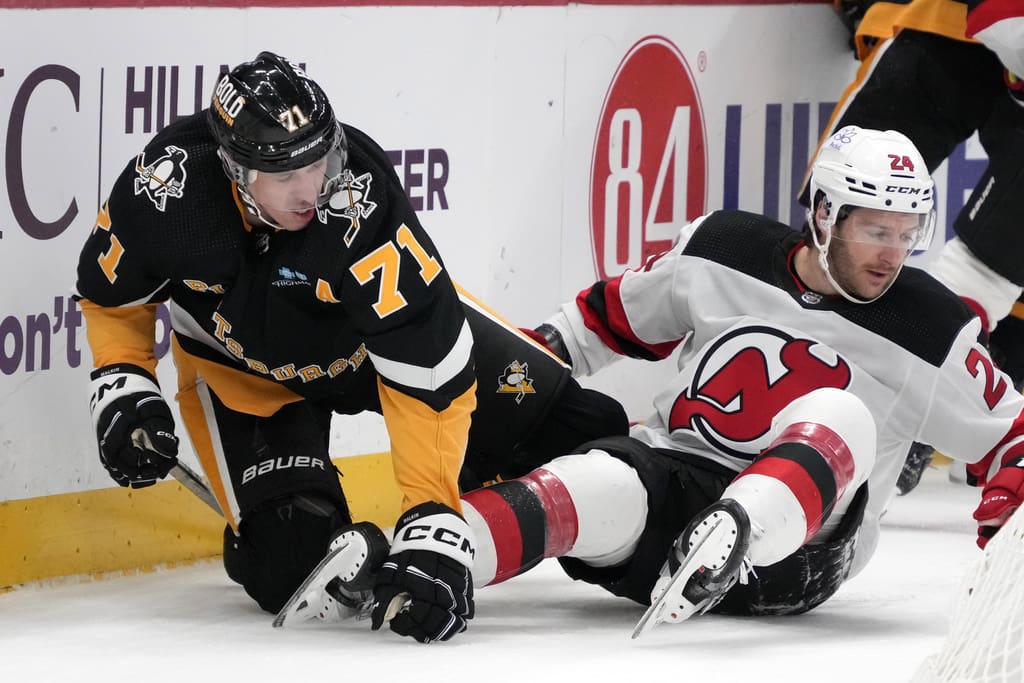Penguins
Kingerski: Penguins Loss Exposed One Missing Ingredient

The Pittsburgh Penguins won five in a row. This season, they’ve beaten three of the best teams in the Western Conference and squashed one of their playoff rivals, the Buffalo Sabres. Yet the loss to the New Jersey Devils, who have now beaten the Penguins six straight times, seemed to pull on a few loose threads.
Over the last two weeks, we’ve seen what the Penguins can do well. Kris Letang admitted to Pittsburgh Hockey Now that the core three players “Aren’t 25 anymore,” and they have to play a different way.
The Penguins have shown coaches and themselves that they can play to their better angels, stay within a structure, and win low-event games rather than willing participants in high-risk games, which have decreasingly gone their way.
And yet, it seemed to unravel against the New Jersey Devils. Long cross-ice passes that became turnovers, not getting pucks deep or hanging onto them in the low zone, and a lack of structure doomed them.
Sidney Crosby said they didn’t have their best and lacked a spark.
“They’re good in transition, and they’re a fast team,” Crosby said. “We didn’t hold onto pucks enough and create enough offensive zone time and just didn’t have a spark that they had. They outplayed us.”
Everyone from Crosby to coach Mike Sullivan flatly panned the Penguins’ performance. There was no reason to belabor it, but there is good reason to examine it.
Bad losses happen. Over an 82-game schedule, even Stanley Cup favorites have bad stretches or have a few no-show losses. It wasn’t an indictment of goalie Tristan Jarry or any one player specifically.
It wasn’t even an indictment of a bad team or the smoking gun to prove the Penguins aren’t a playoff-worthy team that so many fans are oddly trying to assert.
Most fans want their team to succeed, but the Penguins seem to have a healthy number of people rooting for the worst. But I digress.
No, what Thursday’s loss to the New Jersey Devils showed is the Penguins lack enough players able to–in coach Mike Sullivan’s vernacular–drag them into the fight.
This season, that person who has dragged his team into the game or raised the energy level has been Sidney Crosby.
Of course, a big goal or several scoring chances by the big-time players can do that, but what about on nights when it’s not there? Players who aren’t paid to score need to provide more.
Raising the temperature is not supposed to be the first-line center’s role. It’s certainly not supposed to be a 36-year-old star player’s role. And that shows one problem with the Penguins’ construction.
Who is there to stir some chaos? Elevate the energy level, throw a big hit, or put a few mitts in someone’s face?
A finger can be pointed at the Penguins’ bottom-six forwards. Not only has offense production been subpar, but the lines have not combined to generate positive momentum. Make no mistake, the Penguins’ third line with Lars Eller, Drew O’Connor, and Radim Zohorna has been competent, but there’s plenty of room for more production.
Vinnie Hinostroza has improved the Penguins’ fourth line, but the offense is still missing. Fourth-line center Noel Acciari has just one assist in 15 games. The line’s greatest attribute remains the lack of goals given up but little more.
Yet the energy and momentum, the crowd-raising moments, are as sparse as the goals.
It’s time for the fourth line to separate a few more pucks from defensemen with a thundering splat on the end wall. The third line needs to grind down opponents a bit more often.
The winning streak showed the Penguins can win games as a coordinated unit. But the bar to winning gets higher and higher throughout the season. The Pittsburgh Penguins will need more than systematic play and Sidney Crosby (and Evgeni Malkin) to be successful.
And that was the problem exposed on Thursday.












